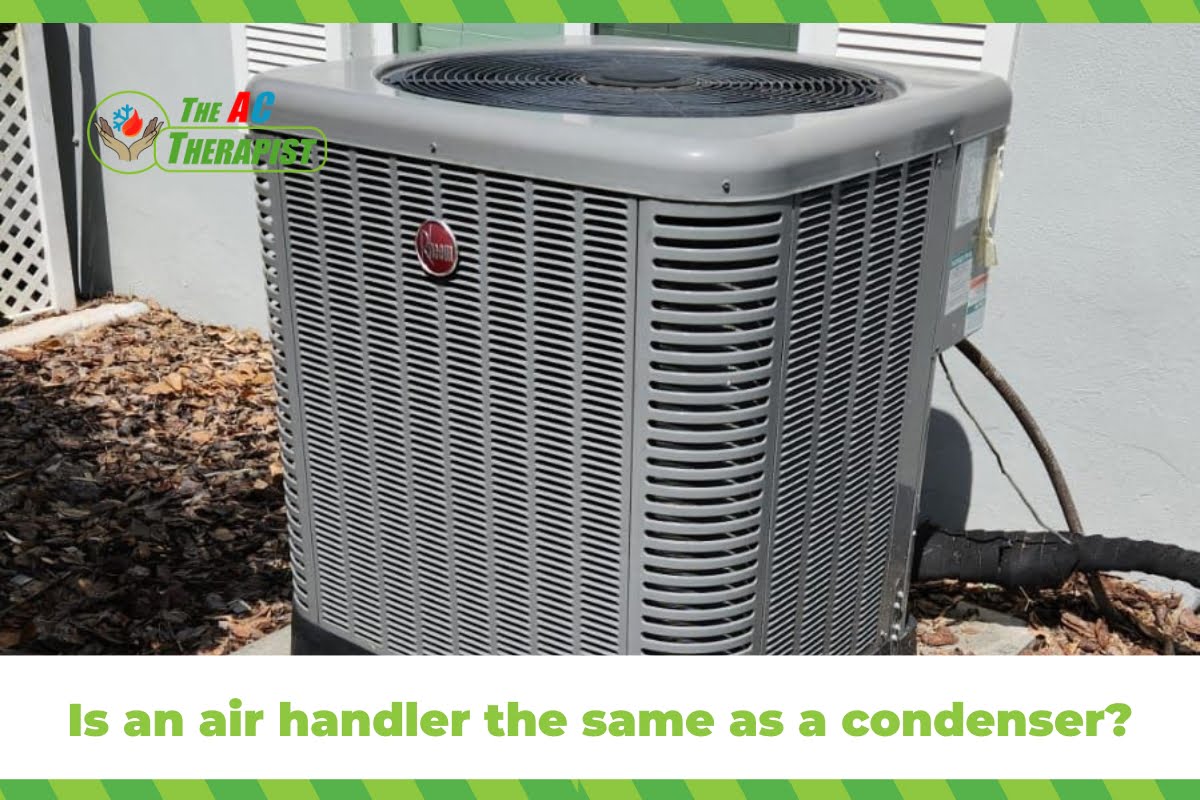Is an air handler the same as a condenser?
When it comes to understanding the various components of a home’s HVAC (Heating, Ventilation, and Air Conditioning) system, homeowners often find themselves puzzled by the technical jargon and the many parts involved. Two such components that frequently confuse are the air handler and the condenser. While both are crucial to the functioning of your HVAC system, they serve different roles. This comprehensive guide will explore the differences between an air handler and a condenser, helping you better understand and maintain your home’s comfort system.
Understanding the Basics
Before delving into the specifics, it’s important to grasp some basic HVAC concepts. Your HVAC system is responsible for maintaining a comfortable indoor environment by regulating temperature and air quality. It typically consists of an outdoor unit (containing the condenser), an indoor unit (often housing the air handler), and a series of ducts that distribute air throughout your home.
What is an Air Handler?
An air handler is a crucial component of a heating, ventilation, and air conditioning (HVAC) system, primarily responsible for circulating and regulating the air within the system. It is typically found inside a residential or commercial building and plays a key role in ensuring efficient and effective heating and cooling. Here are the main features and functions of an air handler:
- Blower/Fan: This is perhaps the most critical part of the air handler. The blower or fan moves the air through the ductwork and into the various spaces of the building. The speed and power of the blower can often be adjusted to control airflow.
- Filters: Air handlers usually contain filters that clean the air as it circulates through the system. These filters trap dust, pollen, and other airborne particles, significantly improving indoor air quality.
- Coils: Depending on the type of HVAC system, the air handler may contain evaporator coils. In cooling systems, these coils hold chilled refrigerant that absorbs heat from the air as it passes over them, thereby cooling the air. In heat pump systems, these coils can also function in reverse, heating the air in winter.
- Dampers: Some air handlers include dampers, which are used to control air flow. These can be adjusted to regulate the amount of air entering different zones of a building, contributing to more efficient heating and cooling.
- Auxiliary Heating Elements: In some systems, particularly in colder climates, air handlers may have additional heating elements (like electric heating coils) to provide supplemental heat.
- Humidifier/Dehumidifier: Some advanced air handlers also have components to adjust the humidity level of the air, either adding moisture (humidifying) or removing it (dehumidifying) to maintain comfortable indoor conditions.
- Connection to Ductwork: The air handler is connected to a system of ducts that distribute the conditioned air throughout the building and return it to the air handler.
- Thermostat Interface: The operation of the air handler is typically controlled by a thermostat, which regulates the temperature of the air being circulated based on the settings input by the user.
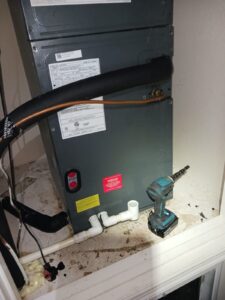
What is a Condenser?
A condenser is a key component in the refrigeration cycle of a heating, ventilation, and air conditioning (HVAC) system, as well as in various types of refrigeration and industrial cooling processes. In the context of a residential or commercial HVAC system, the condenser plays a crucial role in the cooling process. Here’s an overview of what a condenser is and how it functions:
Basic Function
The primary function of a condenser is to release or expel heat from the HVAC system to the outside air. It does this by condensing a refrigerant from its gaseous to its liquid state. In doing so, the refrigerant releases the heat it absorbs from the indoor air.
Key Components of a Condenser
- Compressor: The refrigeration cycle begins with the compressor, which is often considered part of the condensing unit. The compressor increases the pressure of the refrigerant gas and sends it to the condenser coils.
- Condenser Coils: These are a series of tubes or coils through which the hot, high-pressure refrigerant gas flows. As the refrigerant passes through these coils, it loses heat and begins to cool down.
- Condenser Fan: This fan blows outside air over the condenser coils to help dissipate the heat more quickly. The air blown by the fan facilitates the transfer of heat from the refrigerant to the outside air.
- Refrigerant: The refrigerant is the substance that circulates through the HVAC system, absorbing heat from the indoor air and then releasing it outside through the condenser.
How a Condenser Works in an HVAC System
- Heat Absorption: Inside the building, the refrigerant absorbs heat from the indoor air via the evaporator coil, turning from a liquid to a gas.
- Compression: This gaseous refrigerant is then compressed by the compressor, increasing its pressure and temperature.
- Heat Release: The hot, high-pressure gas then travels to the condenser. Here, the refrigerant releases its heat to the outside air, facilitated by the condenser coils and the fan.
- Phase Change: As it loses heat, the refrigerant condenses from a gas back into a liquid. It then returns to the indoor unit’s evaporator to continue the cooling cycle.
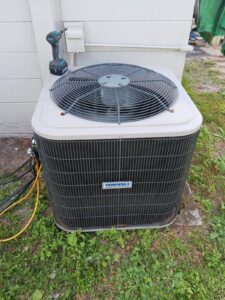
Key Differences Between Air Handlers and Condensers
Understanding the key differences between air handlers and condensers is crucial for anyone looking to grasp how their HVAC system works. While both are essential components of a typical heating, ventilation, and air conditioning (HVAC) system, they serve distinctly different functions. Here are the primary differences:
1. Function and Role in the HVAC System
- Air Handler: The air handler is responsible for circulating and distributing air within the building. It typically contains a blower, filter, and sometimes heating and cooling elements. The air handler takes in air, conditions it (either heating or cooling), and then sends it through the ductwork into the building.
- Condenser: The condenser is a key component in the system’s cooling process. It is primarily involved in expelling heat from the refrigerant. Located in the outdoor unit of an HVAC system, the condenser cools down the refrigerant that has absorbed heat from the indoor air, turning it from a gas back into a liquid.
2. Location
- Air Handler: Usually found indoors, air handlers are often located in spaces like basements, attics, or dedicated utility closets.
- Condenser: This component is part of the outdoor unit of an HVAC system. It’s typically placed outside the home or building, often on a concrete pad.
3. Components
- Air Handler Components: These include a blower fan, air filters, and sometimes heating and cooling elements like evaporator coils (in the case of heat pumps or air conditioners) or electric heating coils.
- Condenser Components: The condenser houses the compressor, condenser coils, a fan, and various controls. It works in tandem with the indoor unit’s evaporator coil.
4. Interaction with Refrigerant
- Air Handler: In systems where the air handler contains an evaporator coil, it interacts indirectly with the refrigerant. The coil cools the air as the refrigerant absorbs the heat from the air.
- Condenser: Directly interacts with the refrigerant. It receives hot, gaseous refrigerant from the compressor and cools it down, causing it to condense into a liquid.
5. Impact on Indoor Air Quality
- Air Handler: Has a direct impact on indoor air quality, as it circulates and filters the air within the building.
- Condenser: Its role is more about heat exchange and does not directly affect indoor air quality.
Importance in the HVAC System
The air handler and condenser are two critical components of an HVAC (Heating, Ventilation, and Air Conditioning) system, each playing a vital role in ensuring the system operates efficiently and effectively. Understanding the importance of each component can help in appreciating how your HVAC system maintains comfort in your home or building.
Importance of the Air Handler
- Air Circulation: The air handler is responsible for circulating air throughout your home or building. It pulls in air from the indoor space, passes it overheating or cooling elements (if applicable), and then redistributes the conditioned air through the ductwork. This continuous circulation is essential for maintaining consistent indoor temperatures.
- Indoor Air Quality: Equipped with filters, the air handler plays a significant role in improving indoor air quality. It filters out dust, pollen, and other airborne particles, ensuring that the air in your space is cleaner and healthier to breathe.
- Temperature Regulation: In systems where the air handler contains heating or cooling elements (like evaporator coils in an air conditioner or heat pump), it directly contributes to regulating the indoor temperature by either heating or cooling the air.
- System Efficiency: The efficiency of an air handler, especially in terms of its blower motor’s energy use, can significantly impact the overall energy efficiency of the HVAC system. Advanced models with variable speed motors can adjust airflow more precisely, enhancing comfort and efficiency.
Importance of the Condenser
- Heat Expulsion: The primary role of the condenser in an HVAC system is to expel heat from the indoor space to the outside. In the cooling cycle, the refrigerant absorbs heat from the indoor air and carries it to the condenser, where it is released into the outdoor air.
- Refrigerant Cycle Completion: The condenser is a key component in completing the refrigerant cycle. By converting refrigerant from a gas to a liquid, it prepares the refrigerant to absorb more heat when it circulates back to the indoor unit.
- System Longevity: Proper functioning of the condenser is crucial for the longevity of the HVAC system. A malfunctioning condenser can lead to increased pressure and temperature, potentially causing compressor failure and other system malfunctions.
- Energy Efficiency: The efficiency of the condenser directly impacts the overall energy efficiency of the cooling system. A well-maintained condenser that effectively releases heat and allows the refrigerant to condense properly can reduce the overall energy consumption of the system.
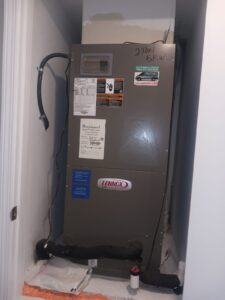
Maintenance Considerations
Regular maintenance of both the air handler and the condenser is crucial for the efficient and effective operation of your HVAC system. Proper maintenance not only ensures optimal performance but also extends the lifespan of the units and can prevent costly repairs. Here’s a guide to maintaining these two key components:
Maintenance of the Air Handler
- Filter Replacement or Cleaning: One of the simplest yet most important maintenance tasks is to regularly replace or clean the air filters. Dirty filters restrict airflow and reduce the efficiency of the system. Filters should typically be checked every 1-3 months and replaced or cleaned as needed.
- Blower Motor and Fan Inspection: The blower motor and fan should be inspected for proper operation. This includes checking for any unusual noises, ensuring the fan is running smoothly, and verifying that the motor is not overheating.
- Coil Cleaning: If your air handler has evaporator coils, they should be cleaned periodically to remove dirt and debris. Dirty coils can impede heat transfer and reduce system efficiency.
- Drain Lines and Pan: Check the condensate drain line and pan for clogs or leaks. A clogged drain line can cause water to back up and potentially damage the system or your property.
- Ductwork Inspection: Inspect the ductwork for any leaks, blockages, or insulation issues. Leaky ducts can significantly reduce system efficiency.
- Overall Inspection: Regularly inspect the air handler for any signs of wear, corrosion, or other damage. Addressing small issues promptly can prevent more significant problems down the line.
Maintenance of the Condenser
- Cleaning the Coils: The condenser coils should be cleaned to remove dirt, debris, and foliage. Dirty coils can’t release heat effectively, reducing the efficiency of your system.
- Inspecting the Fan: Check the condenser fan for any damage to the blades and ensure it is operating smoothly. Replace any damaged fan blades.
- Clearing the Surrounding Area: Ensure that the area around the condenser unit is clear of debris, plants, and other obstructions. There should be at least 2 feet of clearance around the unit to allow for adequate airflow.
- Checking Refrigerant Levels: While this is typically a job for a professional, it’s important to ensure that the refrigerant level is correct. Too much or too little refrigerant can make your system less efficient and shorten its lifespan.
- Inspecting Electrical Components: Check for any signs of wear on the electrical components. Loose connections, worn wires, and corroded contacts can lead to system failures.
- Overall System Check: Regularly inspect the unit for any signs of damage or unusual noises. Early detection of potential issues can save time and money.
Professional Maintenance
While many aspects of air handler and condenser maintenance can be handled by a knowledgeable homeowner, certain tasks should be left to professionals. These include:
- Annual Inspections: Have a professional HVAC technician inspect your system annually. They can perform more complex checks and repairs, such as checking refrigerant levels, inspecting electrical components, and ensuring the system is operating efficiently.
- Complex Repairs: If you encounter any significant issues, such as a malfunctioning compressor, refrigerant leaks, or electrical problems, it’s best to contact a professional.
Common Misconceptions
Addressing common misconceptions about HVAC systems, particularly regarding air handlers and condensers, is important for homeowners and building managers. Misunderstandings can lead to improper use, maintenance, and even unnecessary expenses. Here are some of the prevalent misconceptions:
1. Air Handlers and Condensers are Interchangeable
- Misconception: Some people think that air handlers and condensers are the same or can substitute for one another.
- Reality: Air handlers and condensers have distinct functions within the HVAC system. The air handler circulates and conditions indoor air, while the condenser is crucial in the heat expulsion process in the cooling cycle.
2. Bigger HVAC Systems are Always Better
- Misconception: The assumption is often that a larger HVAC system will provide better cooling or heating.
- Reality: An HVAC system should be appropriately sized for the space it serves. An oversized system can lead to inefficiency, increased wear and tear, and uneven temperature regulation.
3. Closing Vents in Unused Rooms Saves Energy
- Misconception: Many believe that closing vents in unused rooms will reduce energy usage.
- Reality: HVAC systems are designed to distribute air evenly throughout the space. Closing vents can disrupt this balance, strain the system, and actually increase energy consumption.
4. Routine Maintenance is Unnecessary
- Misconception: Some users think that as long as their HVAC system is running, it doesn’t need maintenance.
- Reality: Regular maintenance is crucial for the efficiency and longevity of an HVAC system. Neglecting maintenance can lead to decreased efficiency and higher repair costs in the long run.
5. Air Filters Only Need Replacement Once a Year
- Misconception: A common belief is that air filters in HVAC systems need to be changed only once a year.
- Reality: Air filters should typically be checked and possibly replaced every 1-3 months, depending on usage and environmental factors.
6. Lowering the Thermostat Drastically Cools the House Faster
- Misconception: Some think that setting the thermostat to a much lower temperature will cool the house more quickly.
- Reality: HVAC systems deliver air at a consistent rate, so setting the thermostat much lower won’t cool the house faster but can lead to excessive cooling and increased energy bills.
7. DIY Repairs are Easy and Cost-Effective
- Misconception: There’s a belief that most HVAC issues can be easily fixed without professional help.
- Reality: While basic maintenance might be manageable, HVAC systems are complex and often require professional knowledge and tools for proper repair and servicing.
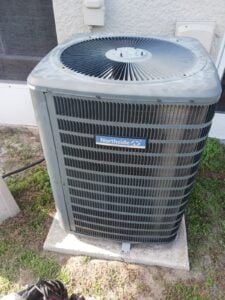
Demystifying HVAC: Is an Air Handler the Same as a Condenser? Insights from The AC Therapist
In conclusion, understanding the distinct roles and functions of air handlers and condensers is crucial for anyone looking to effectively manage their HVAC system. As we have explored, while both components are integral to the overall operation of your heating and cooling system, they are not the same and serve very different purposes. The air handler is key to circulating and conditioning the air inside your space, whereas the condenser plays a critical role in expelling heat during the cooling process.
At The AC Therapist, we understand that navigating the complexities of HVAC systems can be challenging. That’s why we’re committed to providing not only top-notch maintenance and repair services but also valuable information to help our clients in the Tampa Bay area make informed decisions about their air conditioning needs. Remember, regular maintenance by professionals like The AC Therapist can ensure that both your air handler and condenser are in optimal condition, providing you with efficient and reliable indoor comfort all year round.

